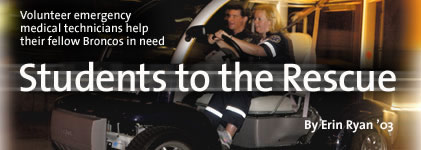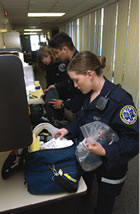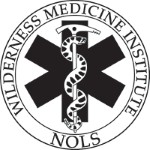Students to the Rescue
Santa Clara Magazine

By Erin Ryan '03
Photos by Charles Barry
Their shifts are 14 hours long and unpredictable, they get no paycheck, and their sleep is often interrupted and minimal. Yet, the Santa Clara University Emergency Medical Services program has thrived and grown dramatically since its 1997 inception. All of the technicians are full-time students who sacrifice more than time to volunteer and be of service to their campus community.
 In October 1997, Matt Donnelly '98 and Sam Suleman '99, both California certified emergency medical technicians (EMTs), approached SCU administrators with the idea of starting an on-campus emergency medical service made up of student EMTs. They saw a need to provide basic emergency care when Cowell Health Center was closed. Donnelly and Suleman split the shifts for the first month, working from 7 p.m. to 7 a.m., seven nights a week. Fortunately for the two founders, six more certified students soon volunteered, and the team responded to 126 calls in the first two quarters.
In October 1997, Matt Donnelly '98 and Sam Suleman '99, both California certified emergency medical technicians (EMTs), approached SCU administrators with the idea of starting an on-campus emergency medical service made up of student EMTs. They saw a need to provide basic emergency care when Cowell Health Center was closed. Donnelly and Suleman split the shifts for the first month, working from 7 p.m. to 7 a.m., seven nights a week. Fortunately for the two founders, six more certified students soon volunteered, and the team responded to 126 calls in the first two quarters.
Today there are about 40 EMS volunteers working 14-hour shifts from 6 p.m. to 8 a.m. Volunteers are required to be California-certified EMTs. They must pass 140 hours of classroom education, 24 hours of riding in an ambulance with other EMTs, and work in an emergency room. They must also pass quizzes and a final skills test where no mistakes are allowed. Last year the EMTs responded to 170 calls, and contrary to popular assumptions, only about 20 percent of calls were alcohol-related.
Awake and on call
Once a week, instead of going to her home in San Jose after classes, Ana Papasin '03 waits by the phone for an emergency. On Wednesdays, Fridays, and Saturdays, the EMTs on duty are required to stay awake and on campus until 2 a.m., and the other nights until midnight. Then they can catch some sleep, but they remain on-call until 8 a.m. Since the EMTs are committed to a response time of two minutes to any call, volunteers such as Papasin who live farther away sometimes end up sleeping, or catching up on studying, in the Emergency Medical Services office located in the Campus Safety building.

Part of the sacrifice of volunteer work is that many EMTs have little time to work at a job that provides a paycheck. "As a full-time student who is also volunteering part-time, and working part-time, it can be taxing," says Evangeline Lindorf '03. The program does not help the student EMTs fulfill their degree requirements, either. Unlike their counterparts at some other universities, SCU EMTs do not receive academic credit for their service.
Experience counts
The volunteer experience does have many other benefits, however. It is valuable experience for those interested in a career in medicine. Former EMT George Kallingal '02 recently took his entrance exams to medical schools, and is volunteering at an AIDS clinic in San Francisco until classes begin. Evangeline Lindorf plans to draw on her EMT experience by earning her master's degree and becoming a physician's assistant, working in an emergency room.
Aspirations to work in the medical field are not the only draws to the service. "Aside from helping people, I'll admit that the unpredictability and the adrenaline rush I get every time there is a call keeps the work exciting and interesting," says Lindorf. Junior Matt Zahler volunteers because he has fun, has gained the confidence to handle many challenging situations, and has made many new friends.
Michele Helms, nurse practitioner and physician's assistant at Cowell Health Center, volunteered to be the medical advisor to the EMTs. Since the program's first quarter, she has given her time to hold weekly meetings with the volunteers to review every call, check up on the previous night's patients, keep records on all of the EMTs, negotiate their budget, and teach many skills to keep their training current. She says the students' many sacrifices inspire her to volunteer.
"I feel honored to do it," Helms says. "I'm incredibly impressed with their dedication, commitment, and confidence. They have no idea what they will find when they respond to a call, but they go in with confidence and professionalism."
Community impact
SCU EMTs also have a significant impact on the greater community by lessening the load of calls going directly to the Santa Clara Fire Department and local ambulance providers. Of the 170 calls last year, only 25 required a 911 response. Many times, the volunteers respond to students who not only need treatment, but also need advice about whether they need to go to the hospital.
Lindorf says she is proud of the program. "We have this year had more serious calls than we've had in the past, and to me that means that our program is becoming more well known, more valued, and trusted," she says. "[I]t offers students help from their peers, which can be less intimidating than going directly to another source."
The program has made a difference, both to the people whose lives have been saved by the EMS treatment, and to the EMTs themselves who have learned lessons in medicine, confidence, and compassion.
For more information, call 408-554-2358 or see www.scuems.com.

